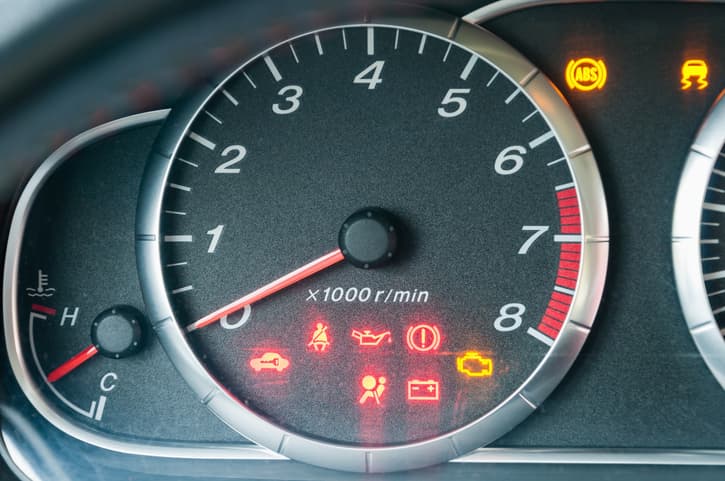Understanding Your Engine Management Lights
Get To Know Your Engine Lights

Nothing quite gets a driver’s heart racing like their engine management light flickering on. But what does it mean, and what do you have to do to make it go away? We reveal all.
WHAT DOES THE ENGINE MANAGEMENT LIGHT MEAN?
The engine management light is a key part of your car’s dashboard. It tells you when something serious is going wrong, and when it’s time for you to do something about it. You’ll be able to see it next to your speedometer, and it will either be the outline of an engine shape or the words ‘check engine’.
If it comes on, something has either gone wrong with your engine or your exhaust system, and it’s time to pay a visit to a mechanic.
The light is connected to your car’s ECU - engine control unit. This is effectively your car’s brain, and it turns the light on whenever it detects something unexpected. Depending on the seriousness of the problem, your light could either be amber, red or flashing on and off.
The only way to truly know what it means is by using a diagnostics scanner. This is a device that plugs into the data port of your car, telling you everything that’s happening under the bonnet. These can be found at all garages, although you can also buy a small one for around €35-€82.
They’ll be able to tell you if it’s a serious problem or something as simple as a loose fuel cap.
WHAT SHOULD YOU DO IF YOUR ENGINE MANAGEMENT LIGHT IS ON?
If your engine management light comes on, it’s a sign that something has gone wrong with either your engine or your exhaust. The first thing to do is notice what colour the light is showing, as they mean different things.
Amber usually means it’s safe to carry on driving, but you should book in for a service soon.
A flashing light means you should be safe to keep driving, but you should book a service in as soon as possible and not drive more than necessary.
If you see a red engine management light, it’s time to pull over as soon as it’s safe and call your breakdown service. A red light means a problem has developed that could affect your vehicle’s ability to drive or steer, making it very difficult for you to get anywhere safely.
COMMON REASONS WHY YOUR ENGINE MANAGEMENT LIGHT IS ON
While the only way to really know why your engine management light is on is by getting it checked with a diagnostics scanner, there are a few common issues that could be causing it.
A Blocked Diesel Particulate Filter
If your DPF gets blocked, it’s a sign that your exhaust isn’t working properly and your car is kicking out more emissions than it should. However, there’s no need to worry. Turn onto a road with a higher speed limit and drive between 48km and 128kmh. This should clear the blockage and turn the light off. If it doesn’t, take your car in for servicing.
Spark Plug Problems
Your spark plugs are what helps your car with ignition. If one of these fails, you’ll likely notice a severe drop in power and difficulties changing gear. It will also turn on your engine management light. Get your car serviced immediately - it’s not a problem that will fix itself.
Low Transmission Fluid
If you run out of transmission fluid, you’ll notice changing gear becomes a real challenge. Fortunately, you can easily top this up at home, turning the engine management light off and making it easy to get going again.
Airflow Sensors
Your airflow sensors tell your car how much air is being sent out of the exhaust. They tell you if your car is burning too much or too little fuel. If a sensor detects a problem, your engine management light will come on and you should take your car to get serviced.
A Blocked Fuel Pump
Over time, it’s easy for your fuel pump to get blocked up with debris and sludge. If this happens it will no longer do its job properly, and could result in your engine suddenly stopping when you’re driving at high speeds.
Vacuum Hoses
On older cars, vacuum hoses were used to remove emissions from around the engine. They’re no longer used in cars as they quite often resulted in the engine management light coming on! If one of your hoses begins leaking, it will mean more emissions build up and your engine could soon overheat. It’s a quick job for a mechanic to sort.
A Broken Catalytic Converter
Potentially one of the most concerning causes of an engine management light is a damaged catalytic converter. This is the thing that turns toxic gases such as carbon monoxide and nitrous oxide into safer emissions. If it breaks, it’s not only awful for the environment, but it could also be bad news for your bank balance.
A Loose Fuel Cap
If your engine management light has to come on for any reason, you want it to be this one. A loose fuel cap means vapours could be escaping from your car, which will make your car less efficient. To fix it, simply pull over and tighten the cap.
HOW TO TURN THE ENGINE MANAGEMENT LIGHT OFF
The only way to turn your engine management light off is to fix the thing that caused it to turn on. In most cases this will require a trip to the mechanic. Once the problem is fixed and the engine is turned back on, the light should disappear.
In newer models, it’s possible to turn the light off using your diagnostic scanner.
However, if you try to cheat and turn it off without solving the issue, the car will always win. The light will just keep coming back on, and eventually the problem will get much worse.
BREAKDOWN ASSISTANCE WITH INSURANCE
If the worst does happen and a big red ‘check engine’ light appears on your dashboard, it could end up costing you a lot of money. That’s why getting breakdown assistance included with your car insurance deal is such a good idea. It will cover the cost of any roadside support, and may even be able to fix the problem there and then.
We compare all the best car insurance deals on the market, helping you find the right offer for you and your car that won’t cause any lights to flash red.
Get your car insurance quote today.
